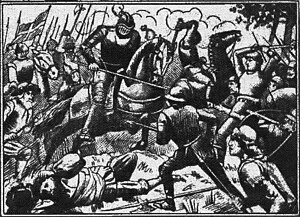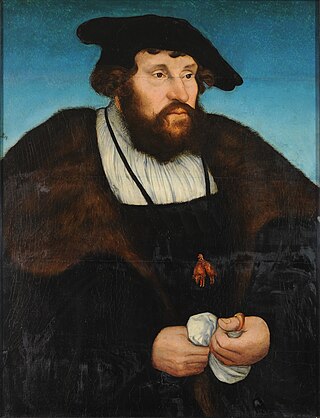
Christian II was a Scandinavian monarch under the Kalmar Union who reigned as King of Denmark and Norway, from 1513 until 1523, and Sweden from 1520 until 1521. From 1513 to 1523, he was concurrently Duke of Schleswig and Holstein in joint rule with his uncle Frederick.

John was a Scandinavian monarch under the Kalmar Union. He was king of Denmark (1481–1513), Norway (1483–1513) and as John II Sweden (1497–1501). From 1482 to 1513, he was concurrently duke of Schleswig and Holstein in joint rule with his brother Frederick.
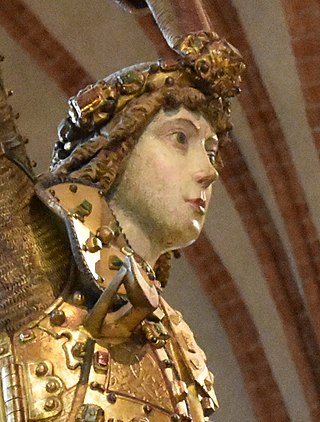
Sten Sture the Elder was a Swedish statesman and regent of Sweden from 1470 to 1497 and again from 1501 to 1503. As the leader of the victorious Swedish separatist forces against the royal unionist forces during the Battle of Brunkeberg in 1471, he weakened the Kalmar Union considerably and became the effective ruler of Sweden as Lord Regent for most of his remaining life.

Dorothea of Brandenburg was Queen of Denmark, Norway, and Sweden under the Kalmar Union as the consort of first King Christopher III of Denmark and later King Christian I of Denmark. She served as interim regent during the interregnum in 1448 and as regent in the absence of her second spouse during his reign. She and Christian had three surviving children: John, Margaret, and Frederick, of whom John served as king of the union and both sons served as kings of Denmark and Norway.
Hemming Gadh was a Swedish Roman Catholic priest and Bishop of the Diocese of Linköping. He was a staunch ally of Sten Sture and a fierce opponent of Denmark and the Kalmar Union.

Ingerd Ottesdotter (Rømer) was her era's wealthiest landowner in Norway. She was the ultimate heiress of the noble Rømer family and a political intriguer. Lady Ingerd is noted for having orchestrated her powerful sons-in-law to support her goals. Her fame was the inspiration for Henrik Ibsen's play Lady Inger of Ostrat.

Lady Ingeborg Åkesdotter Tott or 'Ingeborg Aagesdotter of the Thott', in her lifetime called Ingeborg Åkesdotter or simply Fru Ingeborg, was a Swedish noble, the consort of the Swedish regent Sten Sture the elder. She was the fiefholder of Häme in Finland. She functioned as the de facto queen consort of Sweden for over three decades and participated in state affairs during the reign of her spouse.
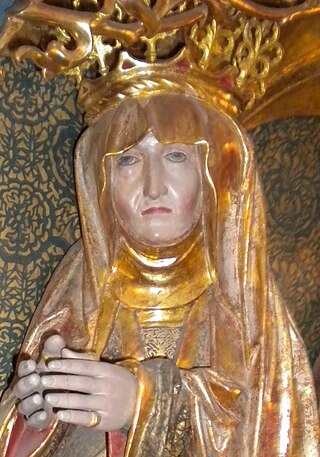
Christina of Saxony, was Queen of Denmark, Norway and Sweden as the wife of King John.
Mette Iversdotter Dyre was a Danish noble, nominal sheriff and chancellor. She was married three times to powerful men: two royal councillors and finally Svante, Regent of Sweden. As such she was a de facto queen consort. Mette Dyre is credited with political influence on the affairs of state through her spouse.

Henrich Krummedige, was born circa 1464 in Norway and died in 1530. He was a Danish-Norwegian nobleman and a member of both the Norwegian and Danish National Councils (Rigsråd) and played an extensive role in the politics of the era. He served as commanding officer of the Bohus Fortress in Norway from 1489 to 1503.
Knut Alvsson was a Norwegian nobleman and landowner. He was the country's foremost Norwegian-born noble in his time and served as fief-holder in southern-central Norway.
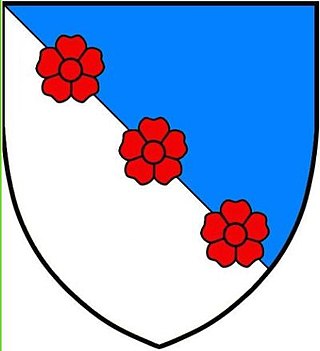
Alv Knutsson was a Norwegian nobleman who descended on his father's side from the influential and wealthy Swedish Tre Rosor noble family. He was a member of the Norwegian council of the realm and also served as commander of the royal castle in Bergen. Alv Knutsson is most famous for his involvement in the Krummedige-Tre Rosor feud. He was the father of the Norwegian rebel leader Knut Alvsson.
Hartvig Krummedige was a Danish nobleman who was born circa 1400 in southern Jutland, Denmark and died in 1476 at Akershus Fortress, Norway.

Görvel Fadersdotter (Sparre) was a Swedish noblewoman and county administrator. She was a major landowner in Denmark, Norway, and Sweden.
Events in the year 1502 in Norway.

The Kalmar Bloodbath, sometimes described as the First Kalmar Bloodbath to distinguish it from a later massacre in the same location, was a politically motivated mass execution that was carried out in Kalmar, Sweden, on July 2, 1505, immediately after a conviction of treason and a sentence of death had been pronounced against participants in the Swedish Uprising against the Danish ruler, King Hans.

The War of Deposition against King Hans was a conflict in which Swedish separatists under the leadership of the Swedish regent Sten Sture the Elder rebelled against the newly elected king of the Kalmar Union, King Hans.

The Krummedige-Tre Rosor feud was a feud that took place from 1448 to 1502 between the Norwegian noble families, Krummedige and Tre Rosor. The feud ended with the extinction of the male Tre Rosor line in Norway, and a stronger monarchy in Norway.

Johan Jepsen Ravensberg was a Danish clergyman and statesman. He served as King's Chancellor from 1486 to 1493 and as Bishop of Roskilde from 1500 to 1512.
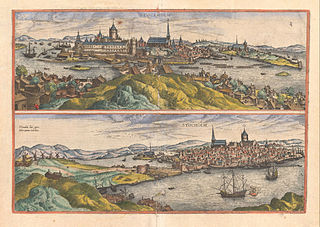
The Siege of Tre Kronor, or the Siege of the Royal Castle in Stockholm, was a siege of the Tre Kronor Castle in Stockholm lasting from 17 October 1501 to 9 May 1502 between the Kalmar Union and Sten Sture the Elder's Swedish rebellion. The besieged unionists would suffer from food shortages, and Queen Christina of Saxony would issue a surrender on 5 May 1501 and would leave the castle on 9 May.
